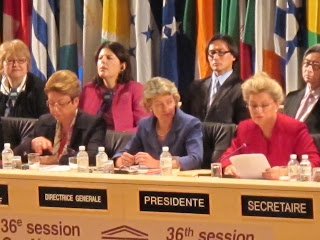 |
| Cesaria Evora © Youri Lenquette / Lusafrica |
BRUSSELS - They call her the 'Barefoot Diva' because she always performs without shoes. But sitting in her dressing room before her appearance at the Palais des Beaux-Arts here, Cesaria Evora is wearing a sedate pair of black house slippers.
Everything else about her is diva-like, from the long, burgundy-coloured nails and many gold bangles, to the flowing patterned blouse. At 56, Evora is enjoying success that took a long time to come her way and she seems a little amused by all the attention she is receiving in Europe .
Evora is acknowledged to be one of the most remarkable singers from Africa and, as Bob Marley did for reggae and Jamaica Cape Verde
"Singers like Marley don't come along very often," Evora says, and the same thing could be said about her. She has a voice that makes people stop and listen to her songs, even if they don't understand Portuguese or Kriolu, the local Creole language.
Critics have called the voice 'powerful', 'extraordinary', 'pure' and 'gutsy'. Whatever you call it, Evora's singing has a remarkable effect on her audience. During her concert in Brussels
Evora's repertoire is based on the 'morna', Cape Verde
Evora's uncle, Francisco Xavier da Cruz (aka B. Leza), was a renowned morna composer and her father also wrote music. She says she doesn't write her own lyrics because she considers herself foremost an 'interpreter' of both new and traditional songs. Her voice completes the poetry of the morna.
 |
| The back cover of 'Cabo Verde' with Evora's autograph |
Evora started singing in her teens at the few bars of her hometown Mindelo, on the island of São Vicente Cape Verde
In 1988, however, when she was 47 years old, a French producer of Cape Verdean Paris Cape Verdean France Paris
Two years (and two albums) later, she released Miss Perfumado, to rave reviews. For many, she was a new Billie Holliday - rare voice, hard life and a passion for alcohol and cigarettes. Within months her concerts were sell-outs and the album went on to sell more than 200,000 copies in France
"It all started with Miss Perfumado," she reminisced. "To have success at this age is something I never expected but it was that album that launched things."
The title song is a haunting, melancholy ballad which was composed by her uncle. Whenever she sings it, the audience remains deathly silent until long after the final note. Then the applause breaks out.
Following the release of Miss Perfumado, Evora went on a global tour, performing in Europe , North and South America and Japan Brazil Brazil Cape Verde Brazil
"We like Brazilian music very much," she says. "There is a lot of similarity because we use the same instruments."
 |
| The front cover of 'Cabo Verde' |
"It's more in line with the traditional music of Cape Verde
The clarinet and saxophone do play a big part in her live shows although the music is driven by strings - the guitar, bass, and the cavaquinho (a small four-stringed instrument) - complemented by the piano. (END/1997) – Alecia McKenzie.
Cesaria Evora died on 17 December 2011 in Cape Verde


















